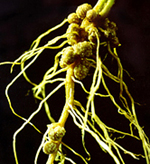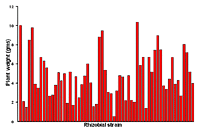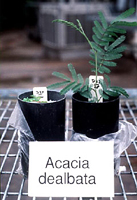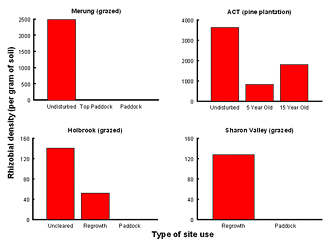Plant-Microbial Associations & Restoration Ecology

Restoration of native vegetation and re-establishment of tree cover is a major conservation focus in Australian farming regions. A consequence of the generally low nutrient levels of Australian soils is that relationships between plants and their microbial symbionts (mycorrhizal fungi as well as N2-fixing bacteria) have particular significance for conservation management, the sustainable use of agricultural lands, and the restoration of degraded ecosystems. Indeed, the benefits of establishing effective symbioses may extend beyond the associated plant host to other species in the community. Despite this, little is known about the diversity of native Australian rhizobial bacteria or their host specificity. Over the past several years we have been conducting a series of studies aimed at obtaining such information, and developing a broader understanding of the importance of plant-soil interactions in community structure and dynamics. Current efforts are focused on assessing the extent to which inoculation with native rhizobia can increase the success of revegetation programs.
Variation in Rhizobial Effectiveness Within Host Species

Results from comprehensive glasshouse inoculation trials indicate enormous variability among rhizobial isolates with respect to their ability to form effective symbiotic relationships with legume hosts.

Not only does this variation translate into large differences in growth rates of particular plant-rhizobial combinations, but recently completed field trials with a range of Acacia species have shown that early growth differences can lead to significant differences in survival. These studies further show that within an Acacia species, elite rhizobial lines (those best at promoting host growth) are highly effective regardless of provenance, meaning that elite strains are likely to be broadly useful within a given host species. However, elite rhizobial lines may be less effective with other species of the same genus, and effectiveness and predictability may decrease further still when using rhizobial strains derived from other legume genera.
TOP
Rhizobial Abundance in Disturbed Sites versus Native Vegetation
During the past two years we have carried out extensive soil sampling to quantify the presence/absence and abundance of native rhizobia in diverse soils. Results from a range of disturbed environments (cleared, grazed, intensive plantation of exotic conifers) show order-of-magnitude differences in rhizobial density in these areas as compared with adjacent undisturbed areas.
 In
some cases, native rhizobia are completely absent from heavily impacted
areas where native shrubs have been cleared or where continual grazing
has occurred over a long period. Although theoretically rhizobia are facultative
organisms their survival is often dependent on the presence of appropriate
hosts. As a result, rhizobia may be entirely absent or present only as
very small populations in soils where revegetation is most crucial.
In
some cases, native rhizobia are completely absent from heavily impacted
areas where native shrubs have been cleared or where continual grazing
has occurred over a long period. Although theoretically rhizobia are facultative
organisms their survival is often dependent on the presence of appropriate
hosts. As a result, rhizobia may be entirely absent or present only as
very small populations in soils where revegetation is most crucial.
We have developed strong research links with Greening Australia Victoria and the North Central Catchment Management Authority in Victoria. We are in the initial stages of a field trial that will provide a major opportunity to assess the value of using native shrubby legumes and rhizobia in revegetation efforts (with a particular focus on areas where dryland salinity is an issue). The project involves 6-10 Acacia species (including A. stenophylla, known to have high salt tolerance) for which we are currently isolating appropriate rhizobial strains, as well as a range of species of Eucalyptus and other non-legumes. The trial is being carried out across 3 geographically distinct areas within the catchment, thus covering a range of soil and moisture regimes. Replicated sites using inoculated and uninoculated Acacia seed are being set up within each area, and a range of information on the abundance of native rhizobia, germination, growth and survival (of both legume and non-legume species) collected over an 18-24 month period.
Scientific Staff: Burdon, Thrall, Young
